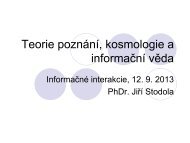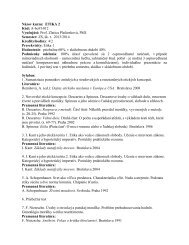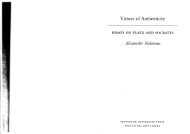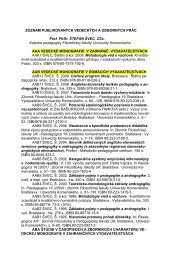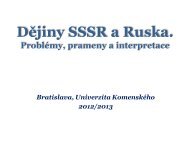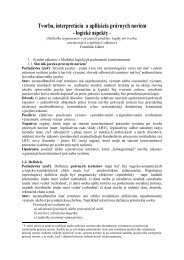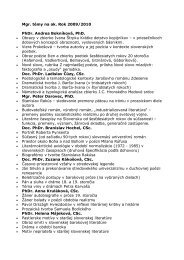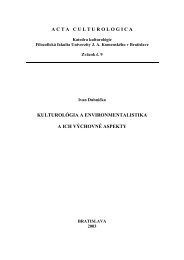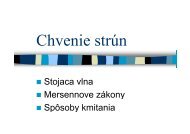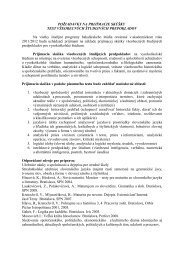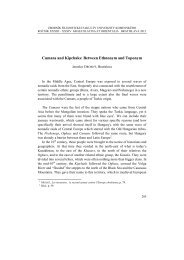Create successful ePaper yourself
Turn your PDF publications into a flip-book with our unique Google optimized e-Paper software.
116 LEXICAL MEANING<br />
Table 6.1 Properties of the basic-level category CHEESE <strong>and</strong> the basic-Ievel<br />
word cheese<br />
TypicaI properties of basíc-level categories<br />
Similarity of food (superordinate): different shapes<br />
shape cheeses (ba ic level): similar hapes<br />
cheddar ( ubordinate): shape that are indistinguishable from<br />
one another<br />
Similarity of<br />
motor<br />
movements<br />
food: meat, cheese, ice cream, nut (erc.) are prepared <strong>and</strong> eaten<br />
with different motions<br />
cheeses: prepared <strong>and</strong> eaten with similar motions<br />
cheddar : prepared <strong>and</strong> eaten with identical motions<br />
Typical properties of basic-level words<br />
Most frequently food: used when referring to mixed collections of food (e.g. the<br />
used contents of a grocery bag), but rarely used to refer to cheese<br />
speei fieally<br />
cheese: oeeurs about 5 times per million words in English<br />
cheddar: oecurs less than 1 time per mill ion words in English<br />
(Dahl 1979)<br />
Most readily<br />
used<br />
Morphologieally<br />
simple<br />
Earliest learned<br />
If shown a pieture of some cheddar, most people say it's cheese,<br />
rather than iťs food or it's cheddar.<br />
superordinate: dairy product = 2 morphemes<br />
basie-level: cheese = I<br />
subordinate: we of ten use eompounds like cheddar cheese<br />
(2 morpheme ) or goat's chee e (3 morphemes)<br />
Children learn to name cheese before hyperonyrns jbozŕ or dairy<br />
product or hyponym cheddar.feta, etc.<br />
Thus we can conclude that while we describe things at many different taxonornic<br />
levels, alllevels are not created equal. The basie levej is perceptually more<br />
salient, <strong>and</strong> therefore the most unmarked (i.e. morphologically implest <strong>and</strong> mo t<br />
broad ly used) level, lingui tically speaking.<br />
Hyponymy <strong>and</strong> word classes<br />
So far, all of our examples of hyponymy have been nou ns, <strong>and</strong> this is typical<br />
in discussions of hyponymy, raising the question of whether inclusion <strong>relations</strong><br />
exist in other word cias es. Certainly, it i more natural to u e noun in X is a<br />
type of Y statements, a shown in (13).<br />
(13) a.<br />
b.<br />
c.<br />
Cheddar is a type of cheese. [nouns]<br />
? To march is a type of to walk. [verbs]<br />
? Nauseated is a type of iiI. [adjectives)<br />
Cru e (1986) propo e that<br />
Xing is a way of Ying insn<br />
copular ("linkjng") verb be<br />
(14) a.<br />
b.<br />
Marching i a wa<br />
Being nau eated<br />
But while we can identif<br />
taxonornies do not tend to<br />
example, it is hard to thin<br />
inc1usion chain marching <<br />
a hyperonym for ili could b<br />
state of health, but notice I<br />
paradigmatic relation to ili<br />
cross word-class boundarie<br />
type of incJusion relation<br />
Is hyponymy éI<br />
While incJusion <strong>relations</strong> ar<br />
tics, it is not clear that ucl<br />
say that the relation betwee<br />
of the relation between com<br />
word s are in a hyponym re<br />
related by inclusion relatio<br />
meaning is only part of the<br />
ub titutable) synonyms ut<br />
<strong>and</strong> dialect as well a deno<br />
to the e non-denotational ii<br />
even though kitty <strong>and</strong> anii<br />
cat is a type of animal JUI<br />
pronouncement of X being<br />
something called kitty is jl<br />
thi rea on, it can be said<br />
both a semantic (i.e. denot<br />
since it involves similarity I<br />
hyponymy is just a semanti<br />
6.2.4 Incompatibilit<br />
The relation di<br />
lapping categories. Incom<br />
can not denote the same thi<br />
patible, a there are no fíov<br />
link flower <strong>and</strong> equatiom<br />
that constitute semantic par



